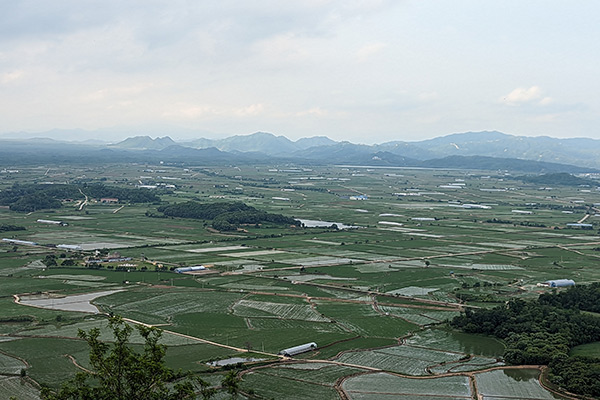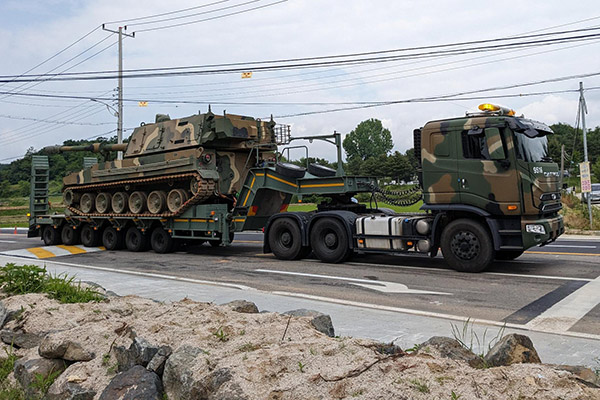Subtotal: $
Checkout
From This Side
Seventy years after the Korean Armistice Agreement was signed, an American living in Korea reflects on the divided nation.
By Trudi Brinkmann
July 27, 2023
We all call him Harabeoji, “Grandfather.” He’s the oldest (and probably best-loved) member of our Yeongwol Community, located in Gangwon Province, South Korea. Born in 1935, he lived through Japanese occupation, the Korean War, and the following decades that brought Korea to its current prosperity. He doesn’t tell about his past often, but now and then he gets talking, and as history pours forth, we hear about the time when this peninsula was one country. He describes how he worked as a bartender on an American army base during the war, how his mother and brother survived the fighting by fleeing south and then up to Seoul, walking for days, if not weeks. He tells about the hometown he left behind. It’s in North Korea now.
This summer, on July 27, it will be seventy years since an armistice was signed. Harabeoji remembers the day: hearing the news over the radio, seeing the notices. For thousands of Koreans, it’s seventy years since they were severed from home and family. Harabeoji, too, had an aunt and cousins who stayed in Communist North. I’m glad he happened to be south of the 38th parallel on July 27, 1953.
I’ve been twice this year to the demilitarized zone, or DMZ, the impenetrable border that divides South Korea from North. My most recent visit was on June 6, Korean Memorial Day. Standing on a platform atop Soi Mountain, I gazed at the distant peaks forming a wide semi-circle to the north. Gentle giants of clouds filtered evening sun rays onto a vast expanse of rice paddies and shadowed a ridge of smaller peaks. Beyond, the sunlight still highlighted a series of hills in an alluring light. I was looking at North Korea.

Photographs courtesy of the author.
I studied the cool green patchwork spreading to the wooded swath of the DMZ. Then I shut my eyes. In my mind, I heard the boom of artillery, thuds, and explosions, the sounds of men at war. Precious fathers, husbands, and brothers falling, dying. Two years into the Korean War, these mountains were a battleground, each side wanting to gain the prize farmland below – and to gain the whole peninsula.
In October 1952, one mountain changed hands twenty-four times in ten days of fighting. Heavy bombing and shelling stripped the hill bare, earning it the name “White Horse Hill.” In those nine days, up to tens of thousands of men died. This is Memorial Day in Korea, I thought. How do you commemorate so many souls and the remains of thousands still to be found? What was the purpose of those lives? Surely not to become collateral damage of selfish superpowers at war.
Other people had climbed the mountain too, including the handful of Yeongwol Community members I’d traveled with. A choir of ten began to sing. Without understanding the words, I heard their yearning for a divided nation to be healed, and the sound carried over the DMZ toward the North.
We’d come to celebrate the completion of construction of a new campus for Border Peace School. Inspired by peacemaking efforts in Ireland, its founder, Jeong Ji-seok, had envisioned this educational facility for exploring themes of peace and reconciliation. He established it in Cheorwon, Gangwon province, which suffered some of the Korean War’s severest fighting. Jeong walks up Soi Mountain with his dog every day, year-round. Looking across rice paddies toward the North, he prays for peace.
The event we were attending began with speeches in Korean, of which I only caught the essence. But the urgency of peacemaking was obvious as some of South Korea’s military trucks, each carrying a tank, rolled up the road mere yards behind us. We sang songs of hope. We prayed. We sat in silence.

As my own voice lifted with hundreds of others in song, it occurred to me that despite dim political prospects, our hope was not futile. And the prayers seemed a greater force against nuclear threat than all of South Korea’s military might.
During my two years living in Korea, I’ve acquired a bit of language, experienced a lot of culture, learned to cook most dishes, and met lots of people. Like many South Koreans of my generation, I’ve often considered North Korea a foreign country. But on other occasions – like the day on Soi Mountain – reality hits: across the DMZ lives the other half of the Korean people.
After the speeches inaugurating the Border Peace School, I watched a young girl in bright traditional costume twirl around stage, beating a complex rhythm on a small hand drum. Other dancers moved in formation, while a trumpet wailed a shrill melody. I wondered whether North Koreans do the same. Do they have anything to celebrate?
They might speak a little differently from South Koreans – after seventy years of separation – and their songs and dances might be in honor of their Great Leader. But as they starve, I imagine they may crave the same delicious dishes that South Koreans (and I) take for granted. They see the same rugged mountains, the same birds, the same sky. As Harabeoji tells me his story and recalls the time “before,” I wonder about his relatives. Do they also recount stories and speak of their family members on the other side? Are they even alive?
This peninsula was once one country, home to one people, and many here wish it once again could be. Somehow. Sometime.
Already a subscriber? Sign in
Try 3 months of unlimited access. Start your FREE TRIAL today. Cancel anytime.







George Pence
Regarding this passage... "This is Memorial Day in Korea, I thought. How do you commemorate so many souls and the remains of thousands still to be found? What was the purpose of those lives? Surely not to become collateral damage of selfish superpowers at war." When I read it I thought of the 40,000 Americans who died fighting in Korea - a few of whom were related to me. Were these young men, and their fellow Koreans, nothing more than the "collateral damage" you describe? Were the American and South Korean Leaders who committed them to this crusade simply selfish, and with no thought for what was best for the people they were hoping to defend? If you are arguing from a pacifist perspective I can understand why you object to violence for any reason. Perhaps it would have been best, and far more Christian, if the South Koreans had simply submitted, didn't accept American military assistance, and then refused to cooperate with the Kim regime. Perhaps that would have worked. After all, it worked over the long haul in India and South Africa. However, people who see it differently, and decide to resist an invading force with defensive force, are not simply being "selfish." And those who bravely die for a good cause aren't little more than "collateral damage."